Unit - 3
Control systems & transfer function-based modelling
Q1) Reduce given B.D to canonical (simple form) and hence obtain the equivalent Tf = c(s)/ R(S)?

A1)




C(S)/R(S) = (G1G2) (G3+G4)/1+G1G2H1)/1-G1, G2(G3+G4) H2/1+G1G2H1
= G1G2(G3+G4)/1+G1G2H1-G1G2H2(G3+G4)
=G1G2(G3+G4)/1+(H1-H2) (G1G2) (G3+G4)
C(s)/R(S) = G1G2(G3+G4)/1+(H1-H2(G3+G4)) G1 G2
Q2) Reduce the Block diagram

A2)




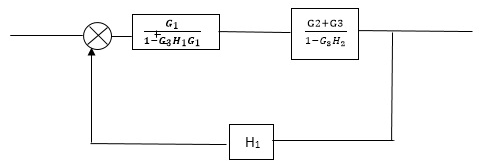

C(s)/R(s)= G1(G3+G2)/(1-G1G3X1) (1-G2X2) H1
= G(G3+G2)/(1-G3G1H1) (1-G2H2) + G1H1(G3+G2)
= G1(G3+G2)/1-G3G1H1-G2H2+G1H1(G3+G2H1
=G1(G3+G2)/1-G3H2+G1G2H1(1+G3H2)
Q3) Draw the free body diagram and write the differential equation for system below.

A3) The free body diagram for M1 will be

Fig: FBD for Mechanical System
F(t) = M1 d2/dt2x1+ B1 d/dt (x1-x2) + k1(x1-x2)
Similarly, for M2we have

Fig: FBD for Mechanical System
K1(x1-x2) + B1d/dt(x1-x2) = k2x2+M2d2/dt2+B2dx2/dt
Q4) For the given polynomials below determine the stability of the system
S4+2S3+3S2+4S+5=0
A4)
Arranging Coefficient in Rows

For row S2 first term
S2 =  = 1
= 1
For row S2 Second term
S2 =  = 5
= 5
For row S1:
S1 =  = -6
= -6
For row S0
S0 =  = 5
= 5
As there are two sign changes in the first column, so there are two roots or right half of S-plane making system unstable.
Q5) Using Routh criterion determine the stability of the system with characteristic equation S4+8S3+18S2+16S+S = 0
A5) Arrange in rows

For row S2 first element
S1 =  = 16
= 16
Second terms =  = 5
= 5
For S1
First element =  = 13.5
= 13.5
For S0
First element =  = 5
= 5
As there is no sign change for first column so all roots are is left half of S-plane and hence system is stable.
Special Cases of Routh Hurwitz Criterions
- When first element of any row is zero.
In this case the zero is replaced by a very small positive number E and rest of the array is evaluated.
E.g. (1) Consider the following equation
S3+S+2 = 0

Replacing 0 by E

Now when E  0, values in column 1 becomes
0, values in column 1 becomes

Two sign changes hence two roots on right side of S-plans
II) When any one row is having all its terms zero.
When array one row of Routh Hurwitz table is zero, it shown that the X is attests one pair of roots which lies radially opposite to each other in this case the array can be completed by auxiliary polynomial. It is the polynomial row first above row zero.
Consider following example
S3 + 5S2 + 6S + 30

For forming auxiliary equation, selecting row first above row hang all terms zero.
A(s) = 5S2 e 30
 = 10s e0.
= 10s e0.
Again, forming Routh array
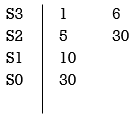
No sign change in column one the roots of Auxiliary equation A(s)=5s2+ 30-0
5s2+30 = 0
S2 α 6= 0
S = ± j 
Both lie on imaginary axis so system is marginally stable.
Q6) Determine the stability of the system represent by following characteristic equations using Routh criterion
1) S4 + 3s3 + 8s2 + 4s +3 = 0
2) S4 + 9s3 + 4S2 – 36s -32 = 0
A6)
1) S4+3s3+8s2+4s+3=0

No sign change in first column to no rows on right half of S-plane system stable.
2) S4+9S3+4S2-36S-32 = 0

Special case II of Routh Hurwitz criterion forming auxiliary equation
A1 (s) = 8S2 – 32 = 0
 = 16S – 0 =0
= 16S – 0 =0

One sign change so, one root lies on right half S-plane hence system is unstable.
Q7) For using feedback open loop transfer function G(s) = 
Find range of k for stability
A7) Findlay characteristics equation
CE = 1+G (s) H(s) = 0
H(s) =1 using feedback
CE = 1+ G(s)
1+  = 0
= 0
S(S+1) (S+3) (S+4) +k = 0
(S2+5) (S2+7Sα12) αK = 0
S4α7S3α1252+S3α7S2α125αK = 0
S4+8S3α19S2+125+k = 0
By Routh Hurwitz Criterion

For system to be stable the range of K is 0< K <  .
.
Q8) The characteristic equation for certain feedback control system is given. Find range of K for system to be stable.
A8)

S4+4S3α12S2+36SαK = 0
For stability K>0
 > 0
> 0
K < 27
Range of K will be 0 < K < 27
Relative Stability:
Routh stability criterion deals about absolute stability of any closed loop system. For relative stability we need to shift the S-plane and the apply the Routh criterion.
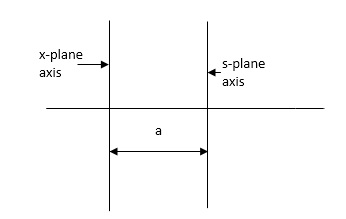
Fig: Location of Pole for relative stability
The above fig 10 shows the characteristic equation is modified by shifting the origin of S-plane to S1= - .
.
S = Z-S1
After substituting new valve of S =(Z-S1) applying Routh stability criterion, the number of sign changes in first column is the number of roots on right half of S-plane
Q9) Check if all roots of equation S3+6S2+25S+38 = 0, have real poll more negative than -1.
A9)

No sign change in first column, hence all roots are in left half of S-plane.
Replacing S = Z-1. In above equation
(Z-1)3+6(Z-1)2+25(Z-1) +38 = 0
Z3+ Z23+16Z+18=0

No sign change in first column roots lie on left half of Z-plane hence all roots of original equation in S-domain lie to left half 0f S = -1
Q10) Compare open and closed loop system?
A10)
Open Loop System | Closed Loop system |
1.It does Not have any feedback. | 1. This system comprise of feedback |
2.As no feedback so easier to build. | 2.As it has feedback so difficult to build |
3.Theaccuracy of this system depends on the calibration of input. | 3.They are accuracy because of the feedback. |
4.Open Loop system are more stable. | 4.In closed Loop system stability depends on system components. |
5.Optimization is not possible | 5. Optimization is possible |
6.These systems are not reliable. | They are more reliable |
Q11) Explain the household and automotive application of control system?
A11)
Household (Media Centre)
A typical Media centre consists of a television, a receiver with its speakers, and a cable or satellite box.
● The User interacts with the media centre using a remote control with the capabilities of turning on or off the system, changing the channel, volume and input (i.e., Cable, DVD player, etc.).
● A media centre will almost certainly have many more functions, however, these are the ones absolutely required for use.
Automotive (Electronic clutch control)
• To relieve pressing of clutch during gear change
• Throttle cable of accelerator pedal replaced by closed loop control system
– Accelerator pedal position sensor and servomotor
– Connected to an ECU for the gear change process
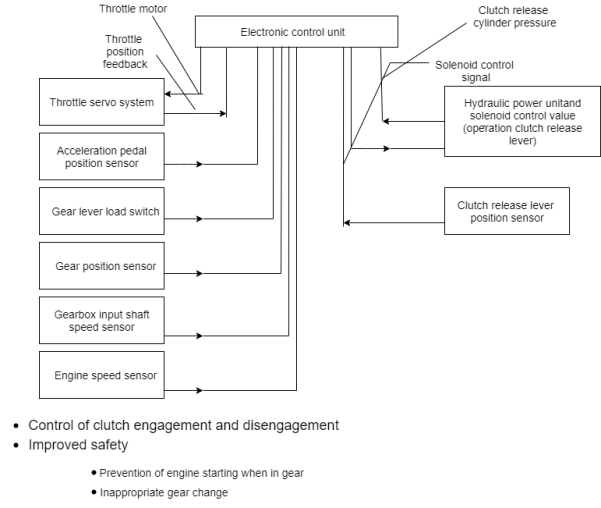
Fig: Block diagram of an automatic clutch and throttle system
Q12) What is industrial application?
A12)
The delivery mechanism supplies material through a narrow slit to form a continuous sheet or web of material. The narrow slit is controlled by an array of actuators, which control the formation of the sheet. Specifically, a movement in one of the actuators in the array influences the product over an area in the region of the actuator’s spatial location and the sheet’s temporal location. The spatial direction across the process is called the cross direction (CD) and the direction of material movement is the machine direction (MD). The properties of the product are normally measured by a scanning device, which measures the web properties by a zigzag path. Scanning sensors of this form are the current industry standard with the dominant manufacturers being ABB, Measurex/Honeywell and NDC/Infrared Engineering.
Q13) Derive the transfer function of thermal system?
A13) List of symbols used in thermal system.
q = Heat flow rate, Kcal/sec.
θ1 = Absolute temperature of emitter, °K.
θ2 = Absolute temperature of receiver, °K.
∆θ = Temperature difference, °C.
A = Area normal to heat flow, m²
K = Conduction or Convection coefficient; Kcal/sec-°C.
Kr = Radiation coefficient, Kcal/sec-°C.
H = K/A=Convection coefficient, Kcal/m2-sec-°C.
H = Thermal conductivity, K cal/m-sec-°C.
∆X = Thickness of conductor, m
R = Thermal resistance, °C-sec/Kcal
C = Thermal capacitance, Kcal/°C
Thermal systems are those that involve the transfer of heat from one substance to another. There are three difference ways of heat flow from one substance to another. They are conduction, convection and radiation.
Consider a simple thermal system shown in the below figure. Let us assume that the tank is insulated to eliminate heat loss to the surrounding air, there is no heat storage in the insulation and liquid in the tank is kept at uniform temperature by perfect mixing with the help of a stirrer. Thus, a single temperature is used to describe the temperature of the liquid in the tank and of the out flowing liquid. The transfer function of thermal system can be derived as shown below.


Fig: Transfer function of thermal system.
Q14) Derive the transfer function of fluid system?
A14) The most frequently used hydraulic device in control system is hydraulic motor-pump set. It consists of a variable stroke hydraulic pump and a fixed stroke hydraulic motor as shown in the below figure. The device accepts a linear displacement (stroke length) input and delivers a large output torque.

The hydraulic motor is controlled by the amount of oil delivered by the pump. By mechanically changing the pump stroke, the oil delivered by the pump is controlled. Like in a DC generator and dc motor, there is no essential difference between hydraulic pump and motor. In a pump the input is mechanical power and output is hydraulic power and, in a motor, it is vice versa.
Let qp = Rate at which the oil flows from the pump
Qm = Oil flow rate through the motor
q = Leakage flow rate
Qc = compressibility flow rate
x = Input stroke length
θ = Output angular displacement of motor
P = Pressure drops across motor
Oil flow rate through motor, qm = Km dt
Where Km = Motor displacement constant.
Leakage flow rate, qi = Ki P
Where Ki = constant.
Compressibility flow rate, qc = Kc dP/dt
Where Kc = Coefficient of compressibility.
In hydraulic systems, normally Kc << Km, therefore, Put Kc = 0 in above equation.

Where  and
and 
The above equation is the required transfer function of hydraulic system.
Q15) What are poles and zeros of transfer function?
A15)
Poles and Zeros of a transfer function are the frequencies for which the value of the denominator and numerator of transfer function becomes zero respectively. The values of the poles and the zeros of a system determine whether the system is stable, and how well the system performs. Control systems, in the most simple sense, can be designed simply by assigning specific values to the poles and zeros of the system.
Let's say we have a transfer function defined as a ratio of two polynomials:

Where N(s) and D(s) are simple polynomials. Zeros are the roots of N(s) (the numerator of the transfer function) obtained by setting N(s) = 0 and solving for s.
The polynomial order of a function is the value of the highest exponent in the polynomial.
Poles are the roots of D(s) (the denominator of the transfer function), obtained by setting D(s) = 0 and solving for s. Because of our restriction above, that a transfer function must not have more zeros than poles, we can state that the polynomial order of D(s) must be greater than or equal to the polynomial order of N(s).
Effect of poles and zeros
As s approaches a zero, the numerator of the transfer function (and therefore the transfer function itself) approaches the value 0. When s approaches a pole, the denominator of the transfer function approaches zero, and the value of the transfer function approaches infinity. An output value of infinity should raise an alarm bell for people who are familiar with BIBO stability. We will discuss this later.
As we have seen above, the locations of the poles, and the values of the real and imaginary parts of the pole determine the response of the system. Real parts correspond to exponentials, and imaginary parts correspond to sinusoidal values. Addition of poles to the transfer function has the effect of pulling the root locus to the right, making the system less stable. Addition of zeros to the transfer function has the effect of pulling the root locus to the left, making the system more stable.
Q16) Explain marginally stable system based on location of poles?
A16) A stable system always gives bounded output for bounded input and the system is known as BIBO stable
A linear time invariant (LTI) system is stable if,
The system is BIBO stable
In absence of the input the output tends towards zero
For system;
1)


Poles on iw axis:
S1, S2 = ± iw.
C(t) = k COS wt.

Fig: Output response of C(t) = k COS wt.
The system is marginally stable than sustained oscillations.
Q17) Explain D’Alembert’s Principle with any example?
A17) D’Alembert’s Principle
For anybody, the algebraic sum of externally applied forces and the forces resisting motion in any given direction is zero.
Ex.

Fig: Mechanical System
In above figure applying D’Alembert’s principle to write the equation of motion
As force f(t) acts downwards all other forces (of k, B, x) acts Opposite to it to considering f(t) as the and all other forces negative.
F(t)+fm (t) + fD(t) +fx(t) =0
f(t)- M d2x(t)/dt2+B dx(t)/dt +x(t)
Q18) Explain special cases of Routh Hurwitz Criterion?
A18) Special Cases of Routh Hurwitz Criterions
- When first element of any row is zero.
In this case the zero is replaced by a very small positive number E and rest of the array is evaluated.
E.g. (1) Consider the following equation
S3+S+2 = 0

Replacing 0 by E

Now when E  0, values in column 1 becomes
0, values in column 1 becomes

Two sign changes hence two roots on right side of S-plans
II) When any one row is having all its terms zero.
When array one row of Routh Hurwitz table is zero, it shown that the X is attests one pair of roots which lies radially opposite to each other in this case the array can be completed by auxiliary polynomial. It is the polynomial row first above row zero.
Consider following example
S3 + 5S2 + 6S + 30
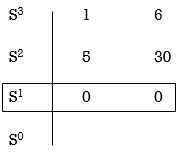
For forming auxiliary equation, selecting row first above row hang all terms zero.
A(s) = 5S2 e 30
 = 10s e0.
= 10s e0.
Again, forming Routh array

No sign change in column one the roots of Auxiliary equation A(s)=5s2+ 30-0
5s2+30 = 0
S2 α 6= 0
S = ± j 
Both lie on imaginary axis so system is marginally stable.